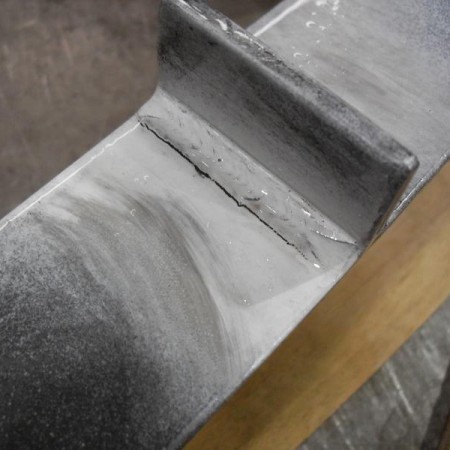 The world has seen several disasters relating to metal fatigue in the energy industry and many of them are the result of weld fatigue throughout history resulting in loss of life and assets worth billions of dollars (The 50 major engineering failures in the energy industry). One of the worst being failures of Alexander Kielland Platform, a semi-submersible drilling rig that capsized due to a small crack that originated from a fillet weld in one of its bracings. British standards for weld fatigue introduced a few decades ago have been serving as a standard for weld fatigue in many industries until today. These nominal stress or hot spot stress methods are widely used in the field for fatigue design evaluation. Design based on these methods requires constructing separate S-N curves from the fatigue testing based on the joint geometry, loading, thickness, etc.
The world has seen several disasters relating to metal fatigue in the energy industry and many of them are the result of weld fatigue throughout history resulting in loss of life and assets worth billions of dollars (The 50 major engineering failures in the energy industry). One of the worst being failures of Alexander Kielland Platform, a semi-submersible drilling rig that capsized due to a small crack that originated from a fillet weld in one of its bracings. British standards for weld fatigue introduced a few decades ago have been serving as a standard for weld fatigue in many industries until today. These nominal stress or hot spot stress methods are widely used in the field for fatigue design evaluation. Design based on these methods requires constructing separate S-N curves from the fatigue testing based on the joint geometry, loading, thickness, etc.
It is also difficult to evaluate the fatigue performance using finite element analysis with FEA being a mesh sensitive evaluation where the calculated stress can vary according to element size, type, etc. To overcome these challenges, Battelle Institute has developed a novel, mesh insensitive structural stress method implemented as Verity for weld fatigue and implemented as a module in FE-SAFE, well-known commercial fatigue, and durability software from Dassault Systemes. In this method, the stresses are calculated using the balanced nodal forces and moments obtained at the weld toe location from the finite element solutions. Working with industry partners, Battelle has also developed a unified master S-N curve that combines the effects of joint geometry, loading modes, and thicknesses. The structural stress procedure has been adopted as design weld fatigue codes by ASME Sec. VIII Div. 2 (ASME Boiler and Pressure Vessel Code) and API 579/ASME FFS-1 (Fitness-for-Service Evaluation).
Verity supports FEA results from ABAQUS, NASTRAN, ANSYS, and I-DEAS. One of the key requirements for using this structural stress method is that the FEA results should include element nodal forces for each element as an output for FE-SAFE to calculate the nodal forces along the welds. From these nodal forces, the equivalent structural stresses are calculated along the weld line to be used for fatigue life prediction. The elements that are supported include Shells, Solids, and Beam elements. The structural stress calculation is based on equilibrium considerations using nodal forces and moments. As a result, the modeling requirements for the presence of welds can be significantly relaxed.
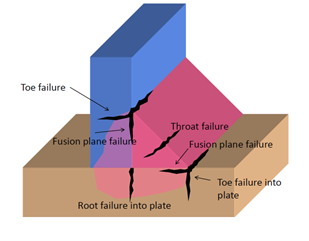
Verity can be used to predict the life of different types of welds including spot welds. The method is based on mapping the balanced nodal forces and moments along an arbitrary weld line available from a FEA run into work equivalent traction. The complex stress along the weld line is represented in the form of a simple stress state in terms of through-thickness membrane and bending stresses at each nodal location. The resulting structural stress calculated is meshed insensitive regardless of the element type, size, and integration order used. Verity uses a single master S-N curve thereby eliminating the need to determine weld classification as in BS7608 and other standards.
Example
To demonstrate the capability, a simple tube model is chosen as shown below with 3D solid mesh and weld fillet meshed using wedge elements. The FE model is fixed at the top end of the pipe and on one side. The other side of the pipe is supporting a twisting load.
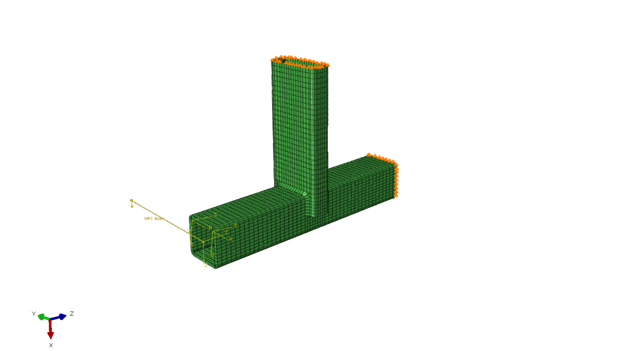
Shown below are the stresses and deformation from the simulation run in ABAQUS. It is to be noted here that requesting nodal forces from each element is essential (not shown here).
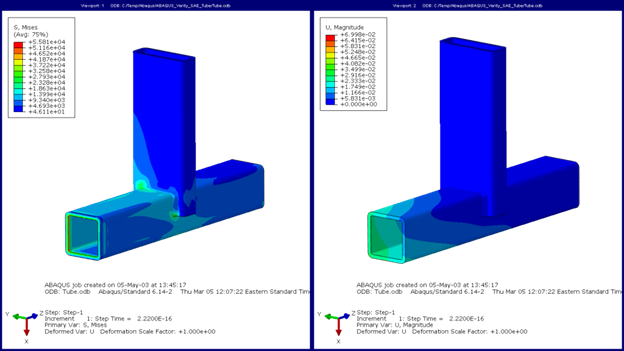
Verity in FE-SAFE
The Verity module is well integrated into the FE-SAFE user interface with a dialog box from the drop-down menu for users to input weld details and calculate equivalent structural stress. Verity in FE-SAFE comes with a database of Master S-N curves for Steel and Aluminum alloy welds.
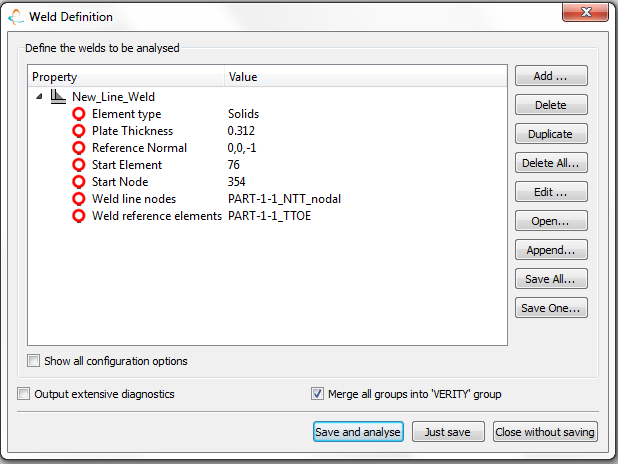
The loading defined on the example problem is a simple cyclic loading with a full load reversal. One of the important features about FE-SAFE is that both Verity module for the welds and FE-SAFE general-purpose fatigue solutions can be employed at the same time to any given model having welds. Verity would be used for predicting weld life and the remaining parts can be solved for fatigue life using FE-SAFE with Brown-Miller strain-based algorithms with Morrow means stress correction. The material is assumed to be SAE-950C for the part and Steel 50% for the weld.
Results
Shown below is the life in log scale with the lowest life reading of 5.1. This is equal to 125,000 cycles with a fusion plane failure. The life of the rest of the structure as predicted by FE-SAFE is around 7.1 on a log scale and is equal to 12.5M cycles. Comparison with an experimental test, the crack showed at the exact location with good correlation on life. For more details on this experiment, please look at the research papers referenced at the end.
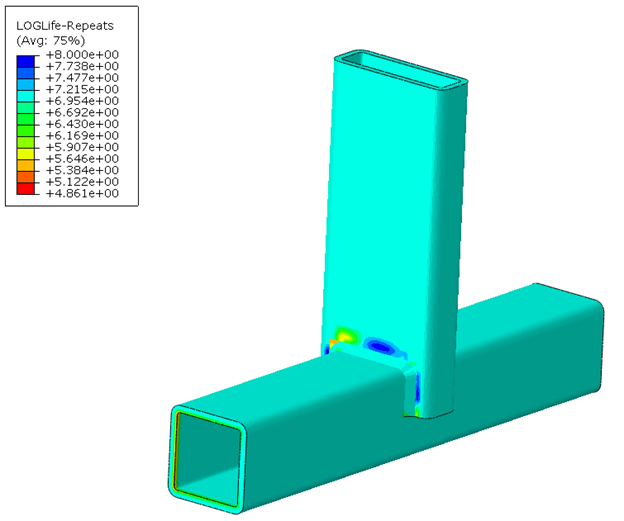
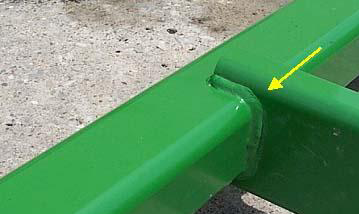
Conclusion
Verity is the only commercially available tool in the market for predicting weld life using the Structural Stress Method adopted by both ASME Sec. VIII Div. 2 (ASME Boiler and Pressure Vessel Code) and API 579/ASME FFS-1 (Fitness-for-Service Evaluation). The example shown above is well documented by Battelle Institute since it was used to demonstrate the capability of this method in the SAE Fatigue Challenge in 2004. The methodology is well proven and is used by industry experts around the world. For more details about it, don’t hesitate to contact us.
References
1. Dong, P., Hong, J. K., and Cao, Z., “A Mesh-Insensitive Structural Stress Procedure for Fatigue Evaluation of Welded Structures, International Institute of Welding, IIW Doc. XIII-1902-01/XV-1089-01, July, 2001.
2. Dong, P., Hong, J. K., Osage, D., and Prager, M., “Master S-N Curve Approach for Fatigue Evaluation of Welded Components,” WRC Bulletin, No. 474, Welding Research Council, New York, New York, 2002.
3. API 579-1/ASME FFS-1, JUNE 5, 2007, The American Petroleum Institute
4. Verity User’s Manual, FE-SAFE Documentation, Dassault Systemes

